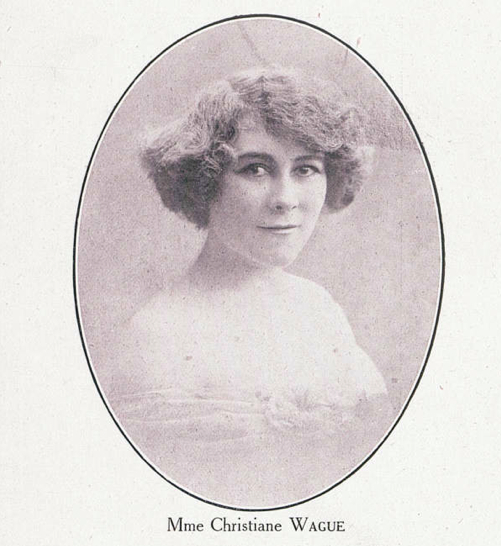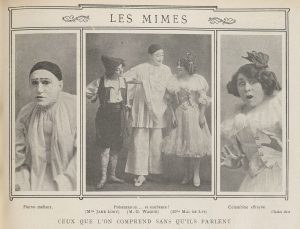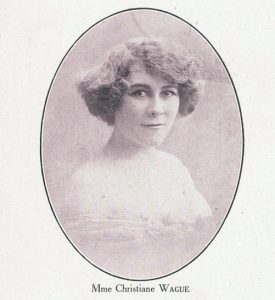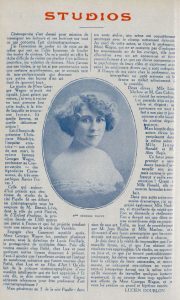Christiane Mendelys’ career as a mime, actress, film critic, and acting teacher mirrored the major developments in French cinema culture, from the early days of cinema as a music-hall attraction, through the first attempts at “theatrical cinema” for middle-class audiences in the mid-1900s and the emergence of newspaper film criticism in the mid-1910s, to, finally, the height of cinema popularity in 1920s Paris. However, unlike fellow critics such as Louis Delluc, Émile Vuillermoz, and Léon Moussinac, her contribution to the development of cinema culture in France has been all but overlooked. While their work circulates in edited volumes, accessing the film criticism of Mendelys requires entering the ornate corridors of the Palais Garnier Opera House, where newspaper clippings of her writings are archived.
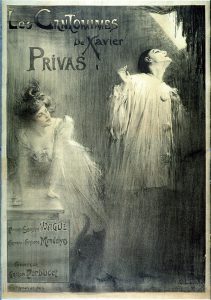
Poster for “Les Cantomimes” (1899), drawn by Charles Léandre. Courtesy of the Bibliothèque Municipale de Lyon.
Pantomime was enjoying a revival in Paris when in the late 1890s the young Mendelys met Georges Wague while studying mime at the Paris Conservatoire under Félicia Mallet. In 1900 countless curious tourists flocked to Paris for the Exposition Universelle, and, according to Le Petit Journal, many of them saw the two perform pantomime at the Roulotte theatre (1933, 6), a show where they shared the stage with the cinématographe (Picard 231). By the mid-1900s, Mendelys was already a renowned mime and recognizable member of the vie parisienne, performing in the belle époque salons of aristocrats alongside her good friend Colette as well as in several theaters. According to reviews in daily press outlets such as Le Matin, La Justice, La Lanterne, Gil Blas, and Le Petit Parisien, by 1907 Mendelys had performed at the Théâtre des Mathurins, the Bodinière, the Gaîté-Montparnasse, the Théâtre des Capucines, the Théâtre d’Antin, the Théâtre Mondain, the Théâtre Rabelais, the Eiffel Tower theatre, the théâtre Grévin, the Grand Guignol, the Théâtre des Bouffes-Parisiens, and the Théâtre de Montrouge. Her nom de ville, Christiane Wague, regularly appears in newspapers on the guest lists for Parisian theatrical events and society fundraisers. According to two separate January 1907 articles in Journal officiel de la république française and Le Temps, her success as a performer was such that that year the French Minister of Public Instruction awarded her the title of officier de l’instruction publique in recognition of her services to the arts (551; 3).
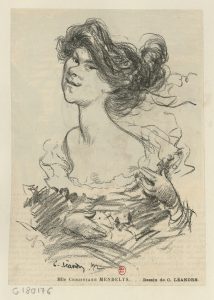
Portrait of Christiane Mendelys by Charles Léandre. Courtesy of the Bibliothèque Nationale de France.
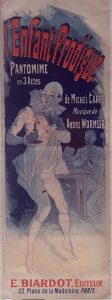
Poster for Michel Carré’s Pantomime “L’Enfant prodigue” (1890). Courtesy of the Bibliothèque Nationale de France.
The early cinema pioneer Edmond Benoît-Lévy saw a commercial opportunity in transferring the popularity of Mendelys and Wague onto the screen. In 1907 he produced a 1600 meter film version of the three-act pantomime performance “L’Enfant prodigue,” directed by its creator Michel Carré for Gaumont (Meusy 188). He was sure to have an eager audience since the pantomime was well known, having enjoyed success at the Théâtre des Bouffes-Parisiens in 1890. In an article published in Comoedia on March 10, 1914, Jean-Louis Croze remembered the film’s release as an important turning point in cinema’s “regeneration” with Benoît-Lévy, providing an “enormous thrust forward” (4). Indeed, the film is an important precedent to the later success of the Film d’Art series created by Paul Lafitte for Pathé the following year. Mendelys played the role of young Pierrot, a part her mime tutor Mallet had originally played in 1890. Benoît-Lévy reserved the Théâtre des Variétés for the film’s premiere on June 16, 1907 and reduced the price of tickets, making the screening an elegant yet accessible event, according to an article in Le Petit Parisien published the day before the screening (La Herse 5). A year before the film’s release the central boulevard area around the Théâtre des Variétés had witnessed the opening of three cinema palaces: the Kinéma Théâtre Gab-Ka, the Cinématograph-Théâtre, and Benoît-Lévy’s Omnia-Pathé. L’Enfant prodigue was thus released into an exciting new landscape of film exhibition in which companies like Pathé and Gaumont increasingly sought to cater to the new bourgeois public with theatrical and artistic subjects.
Negative appraisals of the film made by Carré have come to overshadow the “enormous artistic and financial success” the film garnered with Parisians in the summer of 1907, as reported by one Fulgus in Comoedia (5). Carré retrospectively called it “…un très mauvais film, fait avec toute l’ignorance d’un débutant […]” [Trans.: …a very bad film made with all the ignorance of a beginner] (Coissac 405) and this assertion that the film was “unsuccessful” has been absorbed into contemporary film history, perhaps partially contributing to the erasure of Mendelys’ name (Sirois-Trahan 337). Yet primary sources from the trade press reveal the centrality of Mendelys, Wague, and other mimes in the transition to theatrical film. Edmond Claris, in his November 1, 1909 article in Ciné-Journal, placed them at the center of recent advances in “Cinematographic Theater,” writing:
La séléction s’est faite peu à peu dans le personnel. Pierrot bon enfant a souri devant l’appareil enregistreur. Il a conquis le cinématographe. C’est lui qui triomphe. Dans ce nouveau genre, seul le langage des gestes, seuls, les jeux de physionomie permettent d’exprimer les sentiments, les idées. Voilà comment nous retrouvons là nos deux grands mimes Séverin et Georges Wague. Colombine ne pouvait abandoner Pierrot; Christiane Mendelys a été vite engagée [Trans.: Little by little actors were selected from theaters. The good-humored Pierrot smiled at the cinématographe. He conquered the cinematograph. It is he who triumphs in this new genre where only gestures and facial expressions are capable of expressing thoughts and feelings. There you have them, our two greatest mimes Séverin and Georges Wague. Colombine could not abandon Pierrot, so Christiane Mendelys was quickly employed] (14).
Mendelys’ film career took off immediately. It was Louis Feuillade who spotted her talents on the set of L’Enfant prodigue and asked that she, Wague, and Jeanne Marie-Laurent come to work with him at Gaumont. At the time Feuillade had just taken over from Alice Guy as head of film production and was producing one chronophone film per week. In an interview with the Cinémathèque Française’s historical commission on December 15, 1945, Wague recounted the couple’s beginnings in film and remembered that Mendelys appeared in “an enormous amount” of Feuillade’s chronophone films (12).
Mendelys’ role with Gaumont was not simply as an actress. In a 1910 article for Fantasio she stated that her role included screenwriting. She wrote, “J’ai moi-même imaginé souvent des scénarios de cinéma comme la Légende de la Fileuse, l’Étoile filante, le Fil de la Vierge...Et pensez à mon orgueil: ces pièces là, imaginées et créées par moi, sont sûres de vivre longtemps” [Trans.: I myself have often conceived of scenarios for the cinema, for example, La Légende de la Fileuse, L’Étoile filante and Le Fil de la Vierge…And think how proud I am that these plays that I have invented and created are sure to survive a long time] (567). If only Mendelys had elaborated on her screenwriting role in this interview. How many films lie behind this ellipsis? What we know is that two years into her employment with Gaumont she had “often” written scenarios. The implications of “often” are huge considering that Feuillade made around 700 films during his career.
Fortunately, one can also find sparse references to her screenwriting work in the cinema press. In an adulatory summary of Mendelys’ career for Cinémagazine in 1921 we learn that her acting and screenwriting contributions reach beyond Gaumont to three other major companies: Lux, Pathé, and Film d’Art. According to Lucien Doublon, “Puis elle tourna ensuite chez Pathé, chez Lux et pour quelques autres firmes disparues à présent. Faut-il ajouter que l’excellente artiste est l’auteur de nombreux scenarios qui furent tournés chez Pathé, chez Lux et au Film d’Art?” [Trans.: She then acted for Pathé, Lux and for several companies that no longer exist. Might one add that the excellent actress is the author of many scenarios for films made by Pathé, Lux and Film d’Art?] (20). Another rare allusion to her screenwriting work appears in the Christmas 1919 issue of Le Film. In an overview of French film industry figures, a section called “…and we haven’t forgotten” lists Mendelys as one of cinema’s first scenario auteurs (de Rovera n.p.), and she again appears in the film critics section as a contributor to the daily newspaper Le Victoire. Here, the film critic and scenarist Nozière wrote,
Après avoir joué la comédie et la pantomime, Christiane Wague, qui tourna dans la première bande de 1500m [sic](L’Enfant prodigue) le rôle du Pierrot fils, fut engagée à la Maison Gaumont, où elle fut pendant plusieurs années la protagoniste de films nombreux. Douée d’une vive imagination, elle écrivit des scénarios pour les maisons Gaumont, Lux, le Film d’Art. Sous le pseudonyme Le Rat du Moulin […] elle lutte courageusement pour la défense du film artistique, contre tous les philistins, qui veulent en entraver l’essor. Sa grande compétence dans le métier cinématographique rend sa critique fort intéressante [Trans.: After acting in theater and pantomime, Christiane Wague, who played the role of Pierrot’s son in the first 1500m [sic] film (L’Enfant prodigue), signed to the Gaumont Company where for several years she played the lead role in many films. Gifted with a lively imagination, she wrote scenarios for Gaumont, Lux and Film d’Art. Under the pseudonym Le Rat du Moulin […] she courageously defends artistic film from all the philistines who seek to hinder its development. Her great expertise in the cinema industry renders her criticism extremely interesting] (n.p.).
It would seem that a period of financial hardship brought Mendelys to seek work as a film critic. Her first port of call was Henri-Diamant Berger’s Le Film where her good friend Colette had previously worked as a critic. In September 1917, Wague wrote to Colette on Mendelys’ behalf to ask whether Diamant-Berger had given his answer and to identify their current film critic who was writing under the name La Femme de nulle part (it was the wife of Delluc, Ève Françis). Colette replied that she had not heard from Berger, did not know the mystery critic’s name, and advised against such work since it did not pay (Colette 126-127). From these uncertain beginnings Mendelys soon became one of the most influential film critics in Paris.
Fortunately, a complete record of her criticism can be found in press clippings collected and bound by her husband and held at the Opera Library in Paris. On January 2, 1919, she began a weekly column in the daily newspaper La Victoire under the pseudonym “Le Rat du Moulin.” Here, she explained that, considering cinema’s French birth and the legacy of the frères Lumière, the duty of improving cinema fell uniquely upon the French. She continuously advocated for the promotion of French cinema, and, for example, on January 9, 1919, praised Feuillade as one of France’s best directors (n.p.). She also beckoned Léonce Perret to “return to France as quickly as possible to take up [….] his rightful place” in an article on January 16, 1919 (n.p.). On December 26, 1919, she even called for readers to boycott cinemas that did not show at least two French films in their weekly programs (n.p.).
Her criticism was informed by her technical knowledge of filmmaking, and she paid detailed attention to the scenario and the cinematography, making a point to name the camera operator and showing annoyance, on January 9, 1919, for example, when Gaumont did not provide the name of the camera operator for Feuillade’s Vendémiaire (1919) (n.p.). A first-hand knowledge of film history enlivens her reviews, as do colorful descriptions of daily life as a film critic. In one column, on March 17, 1919, she noted that she missed the beginning of a film because “the trams are always full!” (n.p.). In another piece from June 27, 1919, she gave a first-hand history of the animated film in France, recalling the screening of Émile Cohl’s first animation short Fantasmagorie (1908) and contested the American assertion that Winsor McCay invented the cartoon (n.p.). Her direct address to the reader lends a sense of camaraderie as she asked, “Mais il me semble, cependant, que nos amis et alliés exagèrent autant lorsqu’ils attribuent à Windsor Mac-Cay [sic] l’invention de la caricature animée, que lorsqu’ils insinuent qu’eux seuls ont gagné la guerre. Je n’ai pas vu le fameux premier film de Windsor Mac Cay [sic] (qui l’a vu ici?…)” [Trans.: Yet it seems to me that our friends and allies exaggerate just as much when they attribute the invention of the cartoon to Windsor Mac-Cay [sic] as when they insinuate that they alone won the war. I haven’t seen the famous first film of Windsor Mac Cay [sic] (who here saw it?…)] (n.p.). With the question “who here saw it?” she transformed her column into a participatory sphere much like the letter forums in contemporary women’s fashion magazines such as Les Modes de la Femme de France, in which young women discussed films they had recently seen.
During her first year as critic with La Victoire, Paris saw the release of a new type of film that would come to be known as Impressionist Cinema or the Narrative Avant-Garde (Abel 279). In a February 28, 1919 article, Mendelys greeted the first of these films, Marcel L’Herbier’s Rose-France (1919) with the lines, “Cette façon de ‘visualiser’ les pensées, les souvenirs de ses personnages […] est une manière neuve de comprendre le cinématographe” [Trans.: This way of ‘visualizing’ characters’ thoughts and memories […] is a new way of understanding the cinématographe] (n.p.). On February 21, 1919, she reflected on the public reception of the films: “Il n’est pas certain que ceux qui vont tenter de donner au cinéma une forme nouvelle soient compris tout de suite; il n’est pas sûr, non plus, qu’il réussissent à être immédiatement très intéressants; mais ils auront toujours le mérite d’avoir fait faire un pas en avant sur la route du progrès et il est souhaitable qu’on les encourage et qu’on les aide” [Trans.: It is uncertain whether those seeking to give cinema a new form will be understood straight away; nor is it sure that they will be of immediate interest; but they will still deserve credit for having taken a step forward on the road to progress and I hope they receive help and support] (n.p.). This is not to say that Mendelys was indulgent of First Wave directors in her columns. Although she appreciated L’Herbier’s artistic efforts in Rose-France, she conceded in her February 28 article: “On pourrait même dire, cela serait plus exact, que le scénario lui manque complêtement” [Trans.: One could go as far as saying—and it would be true—that the film is totally missing a scenario]. She continued, “La psychologie des personnages a quelque chose de faux, d’anormal, qui provoque une sorte de répulsion. Leurs sentiments ne sont pas humains; on ne se sent aucune sympathie pour eux, on n’a aucune pitié de leurs chagrins voulus de dilletantes et de neurasthéniques. Leurs larmes mêmes ne sauraient émouvoir” [Trans.: The psychology of the characters has something false, abnormal, provoking a kind of repulsion. Their feelings are not human, we feel no sympathy for them, one has no pity for their dilettante grief and neurasthenia. Even their tears cannot move us] (n.p.).
Mendelys’ column was highly respected in the very masculine world of film criticism. When in early 1920 the journalist Pierre Costar complained that the general public had no one to guide them in their choice or criteria of films, Jean-Louis Croze replied that such advice could be found in the columns of Christiane Mendelys in La Victoire (1920, 3). There is a self-reflexive to-and-fro movement to her writing, as she asserts her expertise and then reflects on her own critical judgment—a self-reflexivity that perhaps came from being a woman critic in a newspaper office full of men. This trait, very much unique to her personal style of film criticism, appears in an October 17, 1919 review of Feuillade’s film L’Engrenage (1919), in which she wrote: “Ce que je reproche à ce scénario, c’est de ne pas oser aller jusqu’à la catastrophe, c’est ce souci, visible, de ne pas déplaire au spectateur en le poussant jusqu’à l’extrême limite de l’émotion, en lui faisant la concession d’un dénouement un peu trop facile. Mais j’ai peut-être tort et le public préfère, sans doute, que tout s’arrange pour le mieux” [Trans.: I reproach this scenario for its palpable fear of displeasing the audience. Instead of pushing them to the extreme limit of their emotions, it doesn’t dare end with a catastrophe, but rather makes the concession of an overly facile ending. But maybe I’m wrong, since the public no doubt prefers that everything turns out alright in the end] (n.p.).
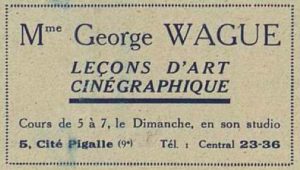
Advertisement for Mendelys’ film school in Ciné pour tous, 1920. Courtesy of the Cinémathèque Française
In 1920, while still working as a film critic, Mendelys opened an acting school with Wague in their Pigalle studio (“Informations” 7). The reputation of Mendelys and Wague as performers in early film lent the school an attractive reputation for aspiring actors in the capital. Although it was reported that they opened the school together, Doublon in Cinémagazine gives the impression that Mendelys was in charge of most of the teaching and the general running of the school. Mendelys told Doublon and Cinémagazine that “Elle […] tient essentiellement à ce que ses élèves comprennent la psychologie de leurs rôles et expriment avec vérité les sentiments divers qui y sont indiqués” [Trans.: She […] wishes her students to understand the psychology of their roles and truthfully express the sentiments of the character] (1921, 20).
Despite Mendelys’ influential career throughout the silent era, there are several striking omissions of her name. When René Jeanne and Charles Ford listed the names of pantomime actors in early French cinema, she is not mentioned (1947, 60). This is more than surprising considering that Jeanne knew Mendelys well and, according to a November 29 article in Le Gaulois, the two were board members of the French cinema press association, known as the Association Professionnelle de la Presse Cinématographique, at the same time in 1922 (1922, 5). Stranger still is that Jeanne, in Cinéma 1900, gives the name of Félicia Mallet instead of Mendelys as the actress in the film L’Enfant prodigue (102).
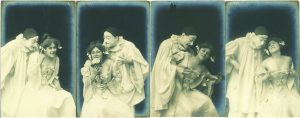
L’Ouïe, L’Odorat, Le Toucher, and La Vue, Christiane Mendelys and Georges Wague. Private Collection.
Recent digitizations of trade newspapers and magazines do help to shed light on such historical oversights, yet the relative anonymity of pre-1910 films means that in publications such as Ciné-Journal (created in 1908), films are listed by title, genre, and length without names of cast members or filmmakers. Although the Gaumont troupe of the immediate prewar years are familiar to film historians, it seems by then Mendelys was no longer with Gaumont as her name does not appear in the luxurious Gaumont Palace programmes of the early teens. Furthermore Mendelys was not in attendance the day her husband attended an interview at the Cinémathèque Française to discuss the career of Feuillade, although actresses Alice Tissot, Renée Carl, and Yvette Andréyor all were. Nor is she named by Carré in his interview with the historical committee the same year. However, Mendelys was consistently at the heart of the French cinema industry, from prewar filmed pantomime and Gaumont sound experiments to the emergence of newspaper film criticism and the vogue for film acting in the 1920s. Though largely forgotten, her career cannot in fact be untangled from the major transitions in French film culture during the silent era.

